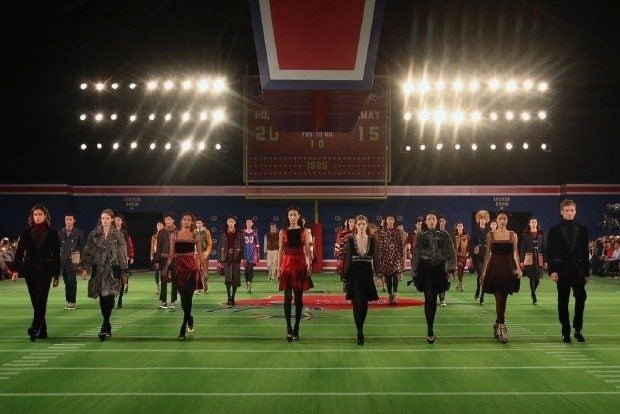
Tommy Hilfiger's fashion show in Beijing. (Weibo/Tommy Hilfiger)
This week, U.S. fashion brand Tommy Hilfiger launched an event in Beijing celebrating 30 years in the business, coinciding with the opening of the brand’s largest store in China. This marked the first time the brand had also held a seasonal runway show launch outside of the United States.
With a runway aesthetic heavily inspired by American football, the party and presentation was aimed at driving home the brand’s “American-ness”—a message that other brands like Coach have deployed to some success in a China market looking beyond Europe for a wider array of brands and fashion cues.
But beyond the glitz and star power at the event lies a more fundamental question for the brand’s prospects in China. Considering similar labels like Ralph Lauren have long struggled to appeal to Chinese consumers using their American touchstones like polo shirts and chinos—an ensemble that remains more coal [boss] than cool— what exactly does Tommy Hilfiger have to offer China?
A key challenge for Tommy Hilfiger is that its brand aesthetic is less all-American aspirational and more mass-market mundane. A wide array of brands—among them Korea’s E-Land—share the same look, feel, and price point as Tommy Hilfiger, making it difficult for the brand (which admittedly helped create this aesthetic in the first place) to make a compelling case as to why Chinese shoppers should care about it.
From this standpoint, Tommy’s decision to use American football—a sport neither followed nor widely understood in China, and certainly not one that resonates with consumers—as the backdrop for its big splash in Beijing is confounding. Expensive, lavish blowouts, which include predictable arrays of flown-in celebrities (in this case, Olivia Palermo and Johannes Huebl), local stars (Zhang Ziyi, Deng Chao), supermodels (Liu Wen, Ju Xiaowen), and the usual “KOLs” invited by every other brand means Tommy will likely continue to struggle in its efforts to stand out in China.
For the invitees, this is just another event among many, all taking place in and around Beijing’s 798, surrounded by the same attendees and covered by the same media outlets and bloggers.
Like fellow American accessible brands Ralph Lauren and Abercrombie & Fitch, and even stumbling accessible luxury brands Michael Kors, Tory Burch, and Kate Spade, Tommy Hilfiger will likely continue to come up against the fact that many aspects that resonate in the United States from a marketing perspective (Kors’s “jetset” lifestyle, Abercrombie’s ab-baring beefcakes, Lauren’s Wild West fixation) simply don’t connect in China.
So the question remains: what is Tommy going to do differently?